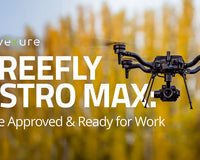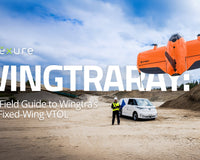Today is the day! Non-hobbyists or
commercial drone operators, who fly
small unmanned aircraft systems (sUAS) or
commercial drones weighing less than 55 pounds, should now follow the
new FAA Part 107 drone regulations and rules as specified by part 107 of the Federal Aviation Regulations. To see the
actual FAA Part 107 regulations on the FAA website please
click here. When we simply say "Part 107", we are referring to the 624 page publication by the FAA which lays out the new rules and regulations that pilots flying drones for commercial use must follow. The following information is intended to shed some light on the
highlights of the new rules pertaining to Part 107, and to analyze the impact they have on
commercial drone operators. Rather than having to read all 624 pages of "Part 107", we hope to provide a quick summary and what you need to know.
Regulations for operating a small UAS (commercial drone operators):
- First and foremost, starting this today, August 29th, Commercial Drone Operators need not have to worry about a Section 333 Exemption, which until now, was mandatory to fly a drone for a commercial use (a job in which you are being compensated for flying a drone). In the sense, there is no more form filling or endless waiting required to fly your commercial drone. Part 107 takes safety as the main parameter to fly a drone rather than the meaningless regulations that are already in place.
- A Commercial Drone Operator flying small UAS, should always operate responsibly and never be reckless. Care should be taken that they never come across a manned aircraft and always avoid flying at an altitude where manned aircrafts often fly.
-
Operators should fly the drone within sight. Within sight, in the sense, means operator should be able to see the drone with naked eye, without the help of visual aids such as binoculars. Solely relying on FPV flying is not acceptable. However, FPV can be used in your sUAS operation as long as you have a visual observer as part of your crew who always has direct line of sight with the drone.

- Even in cases where the operator is using visual aids, care should be taken at all times to see that the drone is close enough so that the operator can act promptly if something unwanted happens.
-
Each operator can only operate one unmanned aircraft at a time. This rule also infers that even the visual observer, apart from the operator, also cannot fly any sort of unmanned aircraft, while one is under operation.
-
Operators can fly their drones either in broad daylight or in twilight. However, they should observe their local timings and should stop flying thirty minutes after the sunset. Nevertheless, they can begin operating their drones thirty minutes before the official sunrise, local time. Care should be taken to see that the unmanned aircraft is equipped with anti-collision lights when flying in twilight.
-
Minimum visibility range for weather is set to three miles from where the operator is operating the drone.
-
Maximum allowed altitude according to the new regulations is 400 feet above the ground. If the drone is within 400 feet of structure, the altitude can be up to 400 feet above the tallest point of the structure, as long as the drone stays within a certain radius of the structure.
- New regulations have set the maximum drone velocity with which one can operate to 100 mph.
-
Operators are not allowed to fly UAS over a person or group of people who are not participating in the operation. Operators are also restricted from flying drones over the persons who are not in an enclosed premises and/or a covered static vehicle.
-
Operators can also prohibited from flying drones while on the move, unless the area of operation is sparingly populated.
-
External loads are permitted to be attached to the UAS only when they are securely fastened and do not have any undesirable effects on the flight quality and its overall controllability.
-
Commercial drone operators are allowed to carry cargo within the boundaries of the state either for compensation or for hire, provided the total weight of the UAS is less than or equal to 55 pounds combined with the cargo.
-
Commercial Drone Operators can apply for a waiver on the weight as well as all of the other operational regulations listed above if he/she can prove that the UAS can be safely operated if a waiver is granted. The Federal Aviation Administration will operate a separate portal for this purpose. It is important to note that a Certificate of Waiver for a variation from these regulations must be filed at least 90 days prior to the operation of the sUAS.
Applying for an FAA Remote Pilot’s License:
Under Part 107, operators who want to become
Commercial drone operators of small UAS need an
FAA Remote Pilot’s License. Operators who do not have the small UAS rating can still fly the drones under the supervision of a person who holds FAA remote pilot’s license.
In order to apply for an FAA Remote Pilot’s License, an operator should posses the following qualifications:

- Operator of the controls should be at least sixteen years old
-
Commercial Drone Operators should pass a preliminary Aeronautical Knowledge Test conducted at one of the knowledge testing centers approved by the FAA. More information on the FAA's Aeronautical Knowledge Test is shown below. All Advexure team members have now taken this exam we are happy to share our tips, recommendations and study plans for this exam.
- Apart from the student pilot certificate, if the operator already has a Part 61 Pilot Certificate, then he/she must take an online small UAS training designed by the FAA. But before taking this online course, the operator must make sure that within the past 24 months he/she has completed at least one flight review.
Small UAS Certification:
The FAA does not assist small UAS operators with the airworthiness principles or on obtaining any sort of aircraft certification. Instead, the FAA states that the operator himself/herself is solely responsible to check whether the drone is safe to take off. The FAA advises the
remote pilots of the sUAS to conduct test flights in a controlled area to ensure that all controls, especially the safety systems of the aircraft, are functioning at their optimum. In addition to checking safety systems,
Commercial Drone Operators are expected to conduct trials to see if all the
communication devices of the sUAS are working properly and are able to communicate clearly with the control station.
Commercial Drone Operators should also take a note that they should get their
small UAS registered before performing any kind of operations. Drone registration is required for all drones weighing more than 0.55 lbs and under 55 pounds. Drone registration costs $5 per aircraft. To register a drone with the FAA, please visit the
FAA's sUAS Registration Site.
Preparing for your FAA Remote Pilot's License Exam - Aeronautical Knowledge Test

All of us here at Advexure can speak from experience,
the test is not as easy as you may think it will be. Yes, a lot of the information on the exam is common senses to a responsible drone operator but there is some content that can be a bit tricky. There are many FAA Remote Pilot prep courses out there but many are way overcharging in our opinion. Here at Advexure,
we all used the RemotePilot101.com course which we really enjoyed. This online course is taught by Jason Schappert, a Certified Flight Instructor and is Airline Transport Rated as well.
There is no one more qualified to be teaching an FAA exam prep course than Jason. Best of all, Jason is offering the course for
just $99 and you get the course for life. He mentioned that he plans on updating the course as things progress. Keep in mind that every two years you will have to take a knowledge exam with the FAA to renew your license so the
RemotePilot101.com training course is a phenomenal value. If you have any questions regarding the new FAA Part 107 Drone regulations and guidelines we're here to help! Have questions about preparing and ensuring you are ready for your big "drone exam" coming up, the FAA Aeronautical Knowledge exam? Please don't hesitate to reach out to our team of FAA Certified Remote Pilots.


 All of us here at Advexure can speak from experience, the test is not as easy as you may think it will be. Yes, a lot of the information on the exam is common senses to a responsible drone operator but there is some content that can be a bit tricky. There are many FAA Remote Pilot prep courses out there but many are way overcharging in our opinion. Here at Advexure, we all used the RemotePilot101.com course which we really enjoyed. This online course is taught by Jason Schappert, a Certified Flight Instructor and is Airline Transport Rated as well. There is no one more qualified to be teaching an FAA exam prep course than Jason. Best of all, Jason is offering the course for just $99 and you get the course for life. He mentioned that he plans on updating the course as things progress. Keep in mind that every two years you will have to take a knowledge exam with the FAA to renew your license so the RemotePilot101.com training course is a phenomenal value. If you have any questions regarding the new FAA Part 107 Drone regulations and guidelines we're here to help! Have questions about preparing and ensuring you are ready for your big "drone exam" coming up, the FAA Aeronautical Knowledge exam? Please don't hesitate to reach out to our team of FAA Certified Remote Pilots.
All of us here at Advexure can speak from experience, the test is not as easy as you may think it will be. Yes, a lot of the information on the exam is common senses to a responsible drone operator but there is some content that can be a bit tricky. There are many FAA Remote Pilot prep courses out there but many are way overcharging in our opinion. Here at Advexure, we all used the RemotePilot101.com course which we really enjoyed. This online course is taught by Jason Schappert, a Certified Flight Instructor and is Airline Transport Rated as well. There is no one more qualified to be teaching an FAA exam prep course than Jason. Best of all, Jason is offering the course for just $99 and you get the course for life. He mentioned that he plans on updating the course as things progress. Keep in mind that every two years you will have to take a knowledge exam with the FAA to renew your license so the RemotePilot101.com training course is a phenomenal value. If you have any questions regarding the new FAA Part 107 Drone regulations and guidelines we're here to help! Have questions about preparing and ensuring you are ready for your big "drone exam" coming up, the FAA Aeronautical Knowledge exam? Please don't hesitate to reach out to our team of FAA Certified Remote Pilots.










